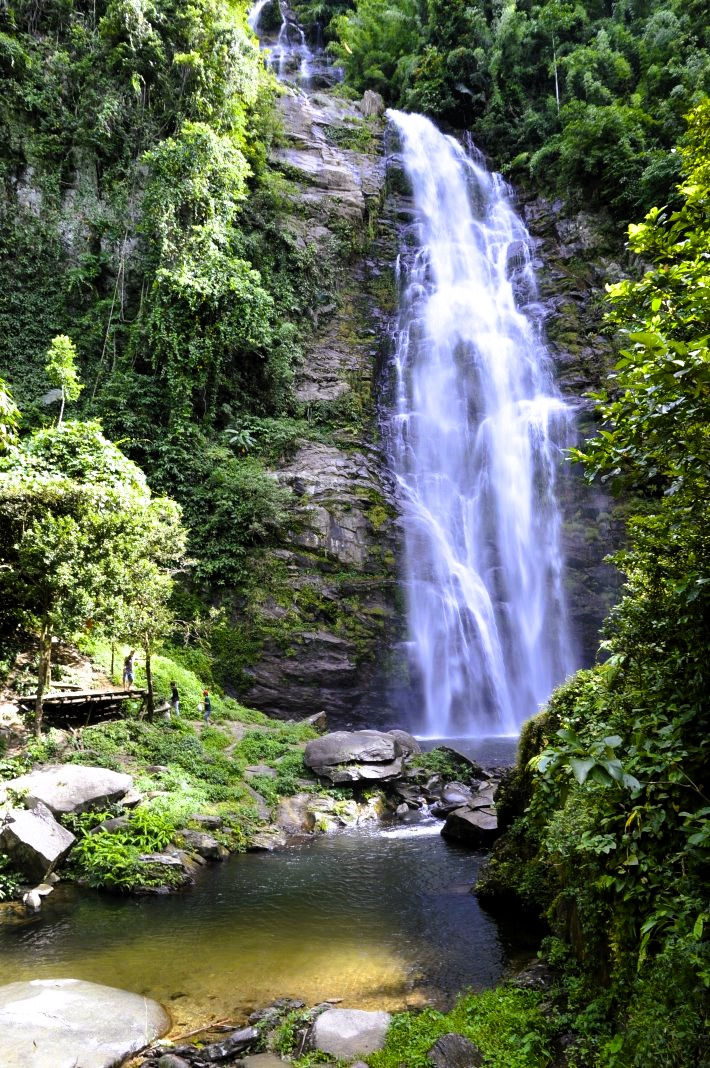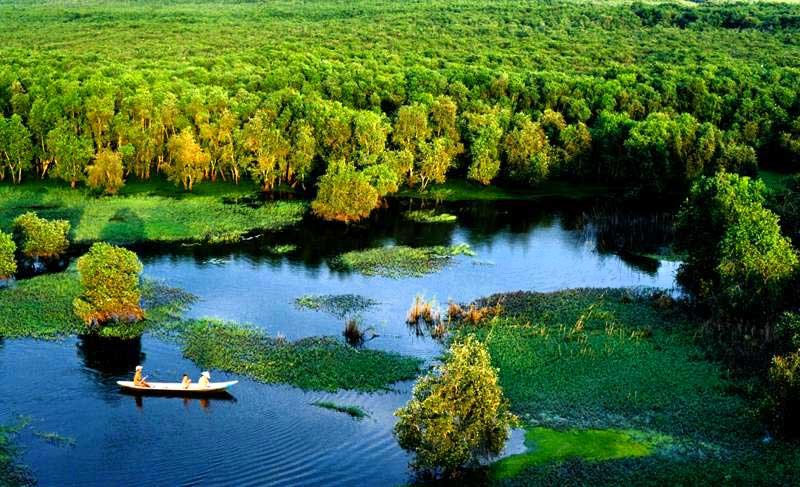The national parks of Việt Nam from north to south - Part 2
- edwardt314
- Nov 8, 2024
- 8 min read
Updated: Jan 16
Updated 11/15/2024
Việt Nam has 34 national parks, spreading fairly evenly in three regions: north, central, and south, with a total area of over 3,000,000 acres. Central Việt Nam has the most number of parks, 14, next is Northern Việt Nam, 11, and last is Southern Việt Nam, 9.
Source: Multiple authors, "Danh sách vườn quốc gia tại Việt Nam," vi.wikipedia.org. Last updated on September 20, 2024. https://vi.wikipedia.org/wiki/Danh_s%C3%A1ch_v%C6%B0%E1%BB%9Dn_qu%E1%BB%91c_gia_t%E1%BA%A1i_Vi%E1%BB%87t_Nam
North Central Việt Nam
Bến En National Park
The park is in Thanh Hóa province, less than 30 miles southwest of the provincial capital, Thanh Hóa City, with the total area of about 36,500 acres. Bến En National Park, a primeval forest, is famous for its ironwood trees, some are at least a thousand year old. On the east side of the park lies Lake Sông Mực, a large lake with the size of 12 square miles, and an average depth of 100 feet. The lake also has 21 islands, large and small, that, together, they resemble a miniature Hạ Long Bay.
Bến En National Park has almost 1,400 plant species and over 1,000 animal species, that include endangered elephant, tiger, and bear.
Source: Hoàng Xuân. "Vườn quốc gia Bến En: "Viên ngọc xanh" giữa đại ngàn." Sở Văn hóa, Thể thao và Du lịch Thanh Hóa. August 20, 2018. https://svhttdl.thanhhoa.gov.vn/di-tich-danh-thang/vuon-quoc-gia-ben-en-1000086
Huy Hoàng. "Ngẩn ngơ bức tranh thủy mặc, sơn thủy hữu tình ở hồ Sông Mực." Dân Việt. September 26, 2023. https://danviet.vn/trai-nghiem-ho-song-muc-tai-vuon-quoc-gia-ben-en-thanh-hoa-20230926143709132.htm
Unknown author. "Vườn Quốc Gia Bến En." benennp.com.vn. Date unknown. https://benennp.com.vn/hoat-dong-bao-ton

Image source: Unknown photographer, "Vườn Quốc Gia Bến En," Year unknown. Accessed via https://benennp.com.vn/ Altered from source photo.

Image source: Blog creator, "Ben En National Park, Thanh Hóa," 2022. Accessed via https://www.youtube.com/watch?v=hlCMQf8idmA Altered from screenshot of video still image.

Image source: Hoàng Anh, "Cận cảnh cây Lim xanh "nghìn tuổi" tại Thanh Hóa," 2021. Accessed via https://dttg.baotainguyenmoitruong.vn/can-canh-cay-lim-xanh-nghin-tuoi-tai-thanh-hoa-328910.html Altered from source photo.
Pù Mát National Park
The park, 72 miles northwest of Vinh (City), is in Nghệ An province, with the size of 235,000 acres. The name, Pù Mát, is in the Thái language, that means "high slope." The park is a dense forest, with steep mountains and deep valleys.
Pù Mát National park is one of the more important sites for mammal conservation in Việt Nam. It has five species that are endemic to the country: white-cheeked gibbon, red-shanked douc (monkey), sao la (Asian bicorn), Trường Sơn muntjac (deer), and Annamite striped rabbit. It is worth noting that sao la is one of the world rarest and endangered large mammals. Other vulnerable species in the park are: Assam macaque (old world monkey), Ussuri dhole (wild dog), Indochinese tiger, and Indian elephant.
In addition to having distinctive mammals , Pù Mát National Park also has almost 2,500 plant species. It is also home to the Thái, Kinh, and Mường minority groups.
Source: Multiple authors. "Pù Mát National Park." en.wikipedia.org. Last updated on June 7, 2024. https://en.wikipedia.org/wiki/P%C3%B9_M%C3%A1t_National_Park
Hoang Quy. "Pu Mat National Park - How to explore wild nature in 2023." wanee.asia. March 22, 2023. https://wanee.asia/pu-mat-national-park-how-to-explore-wild-nature-in-2023/

Image source: Unknown er, "Khe Khem Waterfall," 2024. Accessed via https://english.thesaigontimes.vn/unwinding-in-pu-mat-national-park/ Altered from source photo.
Vũ Quang National Park
The park, about 44 miles west of the provincial capital, Hà Tĩnh (City), has a total area of 136,000 acres. Vũ Quang National Park, an ASEAN Heritage site, is home to about 2,000 plant and animal species, that include the rare sao la (Asian bicorn), giant muntjac (deer), Annamite striped rabbit, and Vietnamese pheasant, that has iridescent blue feather with white tail.
In addition to being a place with rich and diverse wildlife, Vũ Quang National Park is also a place with historical value. It was here that Phan Đình Phùng, a Vietnamese nationalist, and his men rose up and fought against the French colonial government, during the Cần Vương movement.
Source: Unknown author. "Vẻ nguyên sơ tại khu rừng Việt Nam đầu tiên tìm thấy 'kỳ lân châu Á'-sao la." vovlive.vn. May 12, 2022. https://vovlive.vn/ve-nguyen-so-tai-khu-rung-viet-nam-dau-tien-tim-thay-ky-lan-chau-a-sao-la-400799.html
Unknown author. "Vườn Quốc gia Vũ Quang." huyenvuquang.com. Date unknown. https://huyenvuquang.com/vuon-quoc-gia-vu-quang/
Unknown author. "Ha Tinh national park's pristine beauty." dtinews.dantri.com. February 25, 2024. https://dtinews.dantri.com.vn/beautiful-vietnam/ha-tinh-national-parks-pristine-beauty-20240224213847010.htm

Image source: Unknown photographer, "Vu Quang National Park," 2022. Accessed via https://vovlive.vn/ve-nguyen-so-tai-khu-rung-viet-nam-dau-tien-tim-thay-ky-lan-chau-a-sao-la-400799.html Altered from source photo.

Image source: Unknown photographer, "Vườn quốc gia Vũ Quang," 2024. Accessed via https://huyenvuquang.com/vuon-quoc-gia-vu-quang/ Altered from source photo.
Phong Nha-Kẻ Bàng National Park
The park, 141 miles north of Huế (City), is in Quảng Bình province, with a size of 305,000 acres. Phong Nha-Kẻ Bàng National Park, a UNESCO World Heritage site, is a tropical evergreen forest on a limestone plateau. It is known for its 300 grottos and underground rivers. Phong Nha-Kẻ Bàng National Park was created to protect one of the world two largest karst regions, the other is in the Balkans, Europe. It has the world largest cave, Sơn Đoòng, and longest underground river, Nam Aki, almost 9 miles.
Phong Nha-Kẻ Bàng National Park has a forest of Yunnan cypress, with an area of about 12,500 acres, in addition to having over 2,000 plant species, that include three rare and endangered orchid's. The park is home to a significant number of primates, that include the largest population of Francois' langur (Tonkin leaf monkey) in Việt Nam. Other rare and at risk species are the mainland serow (goat-antelope), giant muntjac (deer), and sun bear.
Phong Nha-Kẻ Bàng National Park is also home to a large number of Cham relics, that include ceramics and worship related items, dating back to the 9th century. Also here, during 1885 and 1888, Emperor Hàm Nghi and his loyalists built a base to resist the French invaders.
The three contiguous national parks: Pù Mát, Vũ Quang, and Phong Nha-Kẻ Bàng, have together, almost three-quarter million acres, the largest park system in Việt Nam.
Source: Unknown author. "Phong Nha-Ke Bang National Park." whc.unesco.org. Date unknown. https://whc.unesco.org/en/list/951/
Multiple authors. "Phong Nha-Kẻ Bàng National Park." en.wikipedia.org. Last updated July 6, 2024. https://en.wikipedia.org/wiki/Phong_Nha_%E2%80%93_K%E1%BA%BB_B%C3%A0ng_National_Park

Image source: Unknown photographer, "Son Doong cave among top 7 most beautiful underground attractions," 2024. Accessed via https://vietnam.vnanet.vn/english/tin-van/son-doong-cave-among-top-7-most-beautiful-underground-attractions-367936.html Altered from source photo.
Below is the link to an 11 minute video of Sơn Đoòng cave from the BBC network. They were filming it for the Planet Earth III documentary.
Bạch Mã (White Horse) National Park
The park, about 25 miles south of Huế (City), is in Thừa Thiên Huế province, with a total area of almost 55,000 acres. The mountains in the national park is mostly of granite, with the highest peak, Bạch Mã, at 4,800 feet. Bạch Mã National Park also has the tallest waterfall in Southeast Asia, Đỗ Quyên, at the height of 1,300 feet.
The village of Bạch Mã used to be a popular summer retreat for high ranking French officials, stationed in Huế, during colonial period. At its peak, during 1930s, it had 139 villas and hotels. None of these have survived today.
Bạch Mã National Park has over 2,100 plant species, that include precious agarwood and sempilor (pine). It also has almost 1,500 animal species, that include endangered Asian elephant, white-cheeked gibbon, and red-shanked douc (monkey). The national park is designated as an Important Bird Area (IBA) by Birdlife International because it has a significant number of bird species, that include Vietnamese crested argus (peafowl), Annam partridge, and Edwards' pheasant. Interestingly, Bạch Mã National Park is also known for having a large number of insect species, almost 1,000.
Sourced: Multiple authors. "Bach Ma National Park." en.wikipedia.org. Last updated on October 31, 2024 https://en.wikipedia.org/wiki/B%E1%BA%A1ch_M%C3%A3_National_Park
Multiple authors. "Vườn quốc gia Bạch Mã." vi.wikipedia.org. Last updated on November 30, 2023. https://vi.wikipedia.org/wiki/V%C6%B0%E1%BB%9Dn_qu%E1%BB%91c_gia_B%E1%BA%A1ch_M%C3%A3
Vo Thanh. "Southeast Asia's tallest waterfall in central Vietnam hosts first expedition tour." VNExpress International. January 4, 2024. https://e.vnexpress.net/news/places/southeast-asias-tallest-waterfall-in-central-vietnam-hosts-first-expedition-tour-4691830.html

Image source: Unknown photographer, "Bach Ma National Park," 2021. Accessed via https://vietcentertourist.com/blog/vietnams-top-ten-most-amazing-national-parks.html Altered from source photo.

Image source: Vo Thanh, "Do Quyen Waterfall," 2024. Accessed via https://e.vnexpress.net/news/places/southeast-asias-tallest-waterfall-in-central-vietnam-hosts-first-expedition-tour-4691830.html Altered from source photo.
South Central Việt Nam
Sông Thanh National Park
The park, a former nature reserve, and almost 44 miles west of Hội An, is in Quảng Nam province, with the total size of 500,000 acres. Sông Thanh National park is home to almost 1,200 animal and plant species, that include rare Pơ Mu tree (Fujian cypress), langur (monkey), Asian elephant, and sao la (Asian bicorn).
Source: Unknown author. "Central province promotes Sông Thanh National Park." Việt Nam News. January 4, 2021. https://vietnamnews.vn/environment/842351/central-province-promotes-song-thanh-national-park.html
Linh Bui. "Quang Nam province decides to turn Song Thanh Nature Reserve into a national park." Public Security News. December 21, 2020. https://en.cand.com.vn/law-society/Quang-Nam-Province-decides-to-turn-Song-Thanh-Nature-Reserve-into-national-park-i587506/

Image source: Unknown photographer, "Song Thanh National Park," 2023. Accessed via https://ccd.org.vn/en/tag/song-thanh-national-park/ Altered from source photo.
Núi Chúa (Chúa Mountain) National Park
The park, nestling between Cam Ranh and Phan Rang Bays, and bordering the East Sea (Đông Hải), is in Ninh Thuận province, with a total area of 260,000 acres. Chúa Peak, the highest elevation in the national park, stands 3,400 feet. The national park is in the driest area of Việt Nam, with only 28 inches on the average, per year.
Núi Chúa National Park is known for its sea turtle nesting beaches, and having the largest population of black-shanked douc (monkey) in Việt Nam. It is also home to over 200 mammal and bird species, that include black bear, sun bear, large muntjac (deer), pygmy slow loris (primate), and siamese fireback (pheasant).
Source: Multiple authors. "Núi Chúa National Park." en.wikipedia.org. Last updated on October 23, 2024. https://en.wikipedia.org/wiki/N%C3%BAi_Ch%C3%BAa_National_Park
Multiple authors. "Vườn quốc gia Núi Chúa." vi.wikipedia.org. Last updated on October 27, 2024. https://vi.wikipedia.org/wiki/V%C6%B0%E1%BB%9Dn_qu%E1%BB%91c_gia_N%C3%BAi_Ch%C3%BAa
Unknown author. "Vườn quốc gia Núi Chúa, Ninh Thuận." disanthiennhien.cebid.vn. Date unknown. https://disanthiennhien.cebid.vn/vuon-quoc-gia-nui-chua-ninh-thuan/

Image source: Unknown photographer, "Vườn quốc gia Núi Chúa," Year unknown. Accessed via https://disanthiennhien.cebid.vn/vuon-quoc-gia-nui-chua-ninh-thuan/ Altered from source photo.

Image source: Unknown photographer, "Chà vá chân đen, biểu tượng của Vườn Quốc gia Núi Chúa," 2023. Accessed via https://nld.com.vn/thoi-su/kho-bau-cua-vuon-quoc-gia-nui-chua-20230125161212844.htm Altered from source photo.
Phước Bình National Park
The park, sharing a border with the Bidoup-Núi Bà National Park to the north, is also in Ninh Thuận province, with a size of almost 62,000 acres. The two contiguous parks have a combined total area of 235,000 acres.
Phước Bình National Park has over 1,500 plant and animal species, that include endangered gaur (bovine), Javanese pangolin, Great hornbill, and Vietnam greenfinch.
Source: Multiple authors. "Phước Bình National Park." en.wikipedia.org. Last updated on April 3, 2023. https://en.wikipedia.org/wiki/Ph%C6%B0%E1%BB%9Bc_B%C3%ACnh_National_Park
Multiple authors. "Vườn quốc gia Phước Bình." vi.wikipedia.org. Last updated on September 2, 2024. https://vi.wikipedia.org/wiki/V%C6%B0%E1%BB%9Dn_qu%E1%BB%91c_gia_Ph%C6%B0%E1%B%9Bc_B%C3%ACnh

Image source: Unknown photographer, "Phuoc Binh National Park stands out as an idyllic ecological destination," 2023. Accesed via https://vccinews.com/news/51237/phuoc-binh-national-park-unveiling-the-hidden-treasures-of-the-mountain.html Altered from source photo.

Image photo: Unknown photographer, "Phước Bình National Park," 2024. Accessed via https://vocal.media/education/phuoc-binh-national-park Altered from source photo.
Even though Việt Nam has a later start, not until 1962, I am impressed that it now has 34 national parks, as of 2024. My next blog in this series will be about the national parks in Central Plateau Việt Nam. Please leave a comment if you enjoy reading this.



This is a test. No email is required.